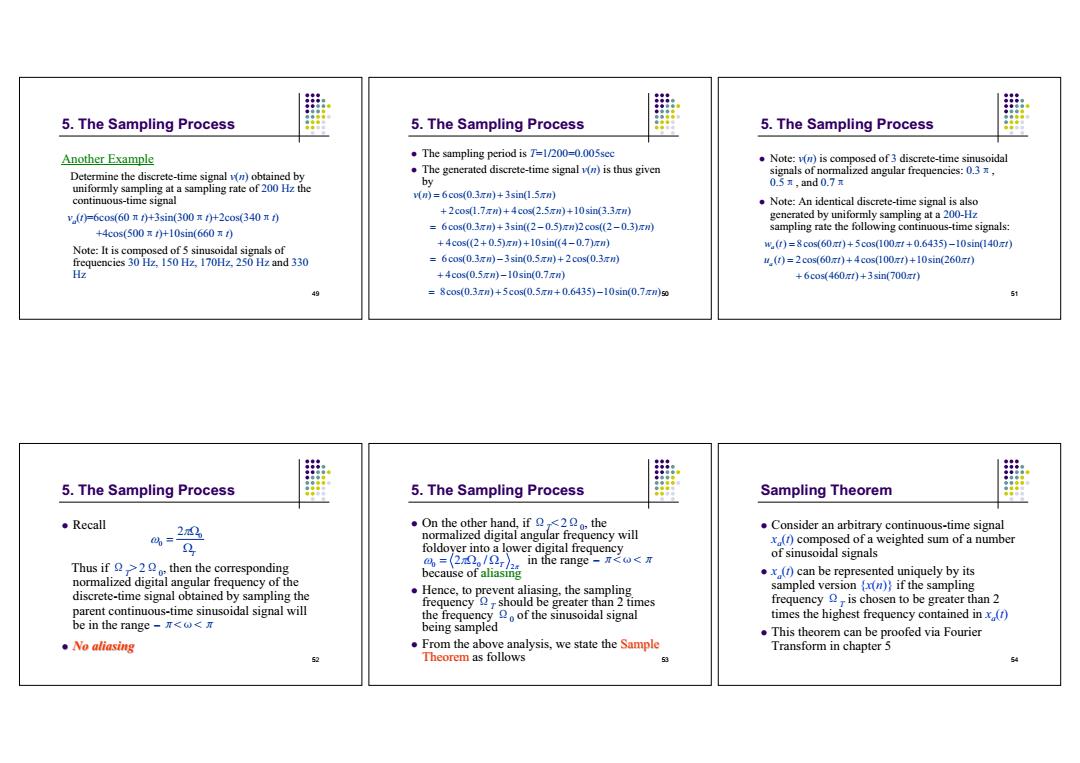正在加载图片...

5.The Sampling Process 5.The Sampling Process 5.The Sampling Process Another Example The sampling period is T=1/200=0.005sec .Note:v(n)is composed of 3 discrete-time sinusoidal Determine the discrete-time signal wn)obtained by The generated discrete-time signal wn)is thus given signals of normalized angular frequencies:0.3, uniformly sampling at a sampling rate of 200 Hz the by 0.5x.and 0.7 continuous-time signal )=6cs(0.3mn)+3sin(1.5r .Note:An identical discrete-time signal is also v(f)=6cos(60 )+3sin(300)+2cos(3401) +2c0s1.7rm+4c0s2.5xn+10sin(3.3x generated by uniformly sampling at a 200-Hz =6c0s(0.3x)+3sin(2-0.5)xm)2cos(2-0.3)Fm) +4cos(500πf)+10sin(660rt1) sampling rate the following continuous-time signals: +4cos(2+0.5)x+10sin(4-0.7)zn) Note:It is composed of 5 sinusoidal signals of ,t)=8cos(60a)+5c0s100xf+0.6435)-10sin(140f) frequencies 30 Hz,150 Hz,170Hz,250 Hz and 330 =6c0s(0.3x-3sin(0.5xn)+2cos(0.3rm (t)=2cos(60mt)+4cos(100mt)+10sin(260mr) Hz +4c0s(0.5xn)-10sin(0.7πm) +6cos(460r)+3sin(700at) 49 =8cos(0.3rn)+5c0s0.5rn+0.6435)-10sin(0.7xnsm 51 5.The Sampling Process 5.The Sampling Process Sampling Theorem 。Recall 22 .On the other hand,if 2,the Consider an arbitrary continuous-time signal -04 normalized digital angular frequency will foldoyer into a lower digital frequency x(r)composed of a weighted sum of a number of sinusoidal signals Thus if 22 then the corresponding =(22。/2r〉2.in the range-r<w<x because of aliasing .x(r)can be represented uniquely by its normalized digital angular frequency of the Hence,to prevent aliasing,the sampling sampled version (x(n)if the sampling discrete-time signal obtained by sampling the frequency should be greater than 2 times frequency is chosen to be greater than 2 parent continuous-time sinusoidal signal will the frequency o of the sinusoidal signal times the highest frequency contained inx(r) be in the range being sampled This theorem can be proofed via Fourier 。No aliasing From the above analysis,we state the Sample Transform in chapter 5 52 Theorem as follows 5349 5. The Sampling Process Another Example Determine the discrete-time signal v(n) obtained by uniformly sampling at a sampling rate of 200 Hz the continuous-time signal va(t)=6cos(60±t)+3sin(300±t)+2cos(340±t) +4cos(500±t)+10sin(660±t) Note: It is composed of 5 sinusoidal signals of frequencies 30 Hz, 150 Hz, 170Hz, 250 Hz and 330 Hz 50 5. The Sampling Process The sampling period is T=1/200=0.005sec The generated discrete-time signal v(n) is thus given by ( ) 6cos(0.3 ) 3sin(1.5 ) 2cos(1.7 ) 4cos(2.5 ) 10sin(3.3 ) 6cos(0.3 ) 3sin((2 0.5) )2cos((2 0.3) ) 4cos((2 0.5) ) 10sin((4 0.7) ) 6cos(0.3 ) 3sin(0.5 ) 2cos(0.3 ) 4c vn n n nn n n nn n n nn n
os(0.5 ) 10sin(0.7 ) 8cos(0.3 ) 5cos(0.5 0.6435) 10sin(0.7 ) n n nn n
51 5. The Sampling Process Note: v(n) is composed of 3 discrete-time sinusoidal signals of normalized angular frequencies: 0.3±, 0.5±, and 0.7± Note: An identical discrete-time signal is also generated by uniformly sampling at a 200-Hz sampling rate the following continuous-time signals: ( ) 8cos(60 ) 5cos(100 0.6435) 10sin(140 ) ( ) 2cos(60 ) 4cos(100 ) 10sin(260 ) 6cos(460 ) 3sin(700 ) a a wt t t t ut t t t t t
52 5. The Sampling Process Recall Thus if ¡T> 2¡0, then the corresponding normalized digital angular frequency of the discrete-time signal obtained by sampling the parent continuous-time sinusoidal signal will be in the range ˉ±<¹<± No aliasing 0 0 2 T 53 5. The Sampling Process On the other hand, if ¡T< 2¡0, the normalized digital angular frequency will foldover into a lower digital frequency ¹0={2±¡T /¡T} 2in the range ˉ±<¹<± because of aliasing Hence, to prevent aliasing, the sampling frequency ¡T should be greater than 2 times the frequency ¡0 of the sinusoidal signal being sampled From the above analysis, we state the Sample Theorem as follows 0 0 2 2 / T 54 Sampling Theorem Consider an arbitrary continuous-time signal xa(t) composed of a weighted sum of a number of sinusoidal signals xa(t) can be represented uniquely by its sampled version {x(n)} if the sampling frequency ¡T is chosen to be greater than 2 times the highest frequency contained in xa(t) This theorem can be proofed via Fourier Transform in chapter 5���������������������������